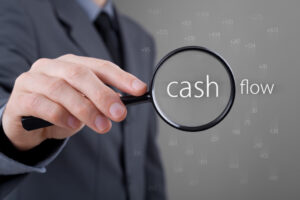
Profit (or loss) also known as net income (or net loss) are commonly referred to as the bottom line of a company because this figure sits at the bottom of the Profit and Loss statement. Net profit occurs when there is a surplus (or positive amount leftover) after all the expenses of running the business have been deducted from the revenue billed to customers. A loss (or negative profit) can of course incur if expenses are greater than revenue.
Cash flow is another beast entirely.
Positive cash flow occurs when the net amount of cash that flows in and out of a business during a period of time is greater than zero. In a nutshell, it means that the bank account of the business went up during the period because the company’s liquid assets are increasing. And for those of you following along with the Penny and Ernest metaphor, it means that the amount Ernest collected and put into the bank account, exceeded the amount that Penny spent.
KEY POINTS:
- It is possible for a company to have positive cash flow while reporting a loss on the Profit and Loss
- If a company has positive cash flow it means that it’s liquid assets increased over that period of time
- It is entirely possible for a company to post a loss on its Profit and Loss but still have positive cash flow because it received enough cash from borrowing and investing activities to offset the loss for accounting purposes
ANALYSIS:
Net profit or loss from the Profit and Loss statement is merely the starting point for calculating cash flow. Most businesses use something called “accrual accounting”, which means that profit includes revenue and expenses that may be collected or spent at some future point in time and some non-cash amounts. And if these items haven’t (or won’t) hit the bank account, they aren’t relevant to cash flow.
Since the Profit and Loss contains stuff that hasn’t happened yet (or is not relevant to cash), we cannot rely on it solely to make good decisions for the business. We must remove or adjust everything that hasn’t happened yet or is not relevant to cash, in order to get back to a number that represents pure cash flow. Said another way, we are looking to isolate the amount that Penny and Ernest have each run during the period.
To do this in practice, we need to look at the inter-relationship between the Profit & Loss statement and the Balance Sheet. This holistic perspective will give us a true picture of cash flow.
EXAMPLE:
For example, if we were to start from a position where the expenses of a business exceeded revenue (i.e. a net loss or negative income), the most likely result would also be negative cash flow. It is always more difficult to achieve positive cash flow when the business starts from the position of operating at a loss.
However, it is entirely possible to start with a net loss and simultaneously achieve net positive cash flow, but the following scenarios (which are not an exhaustive list) would have to happen in order for that to be feasible:
- The company could receive an influx of cash from either borrowings (i.e. bank debt) or the injection of further equity via investors.
- If the company has a net loss and also a large amount of depreciation expense recorded, the add-back of the depreciation expense (which is a non-cash item since no money leaves the business when depreciation is deducted for tax purposes) could push the company into positive cash flow territory.
- The sale of an asset, or just the reduction in total fixed assets over the period due to depreciation, could also kick up enough cash to help the company record positive cash flow under certain scenarios.
- The collection of receivables (or other money owed) that were posted in a prior accounting period but were collected and put into the bank in the current period is another simple way to push a company into a cash flow positive zone.
- Expenses are recorded on the Profit and Loss when they are incurred, not when they are paid. If a company posts a net loss due to a large amount of accrued expenses (where they were deducted in computing the loss but are not due to be paid until a subsequent financial period), it is entirely possible that the adjustment for these expenses might enable a company to maintain positive net cash flow, despite recording a net loss for tax purposes.








